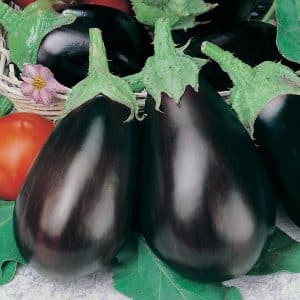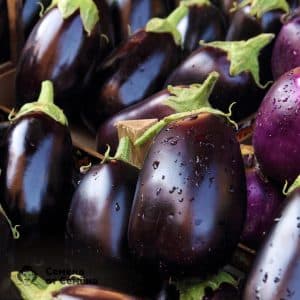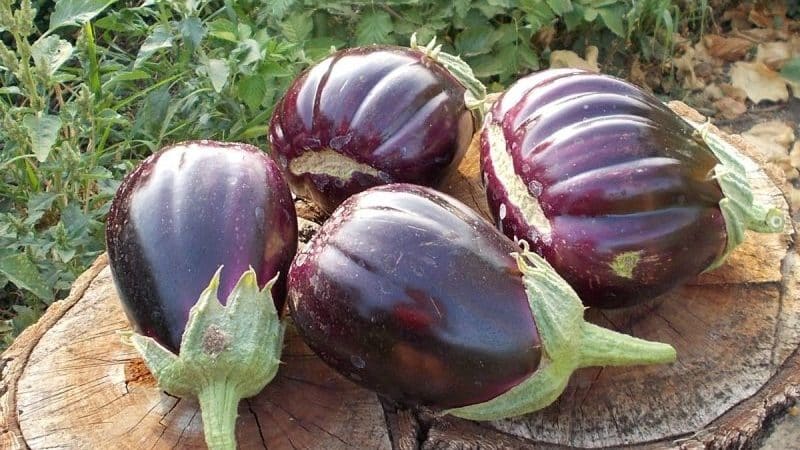Why summer residents like the “Black Beauty” variety of eggplant and how to grow it
Many summer residents do not dare to grow eggplants in their beds, considering this vegetable crop to be too capricious. But thanks to the efforts of breeders, new varieties and hybrids are emerging that are resistant to changeable weather. One of these representatives of the nightshade family is variety Black handsome.
Description of the eggplant variety
The variety is mid-ripening: in open ground the fruits ripen 120–140 days after planting. Black Beauty feels comfortable in the garden beds in the southern regions of Russia. The variety is adapted to temperature changes and is resistant to many diseases. However, in the Urals and in the middle zone it is better to grow the crop in greenhouses.

Distinctive features
The characteristics of the variety include an excellent combination of yield indicators and resistance to adverse weather conditions. The black beauty does not stop producing fruits even in bad weather, which makes it different from other representatives of the culture.
Characteristics
The variety forms compact spreading bushes that grow up to 70 cm in height. The stems are covered with fluff, the leaves are small with jagged edges and have an emerald hue.. Throughout the season, the crop is decorated with large light purple flowers.
 Black beauty produces large pear-shaped fruits weighing 110–200 g. At the stage of technical maturity, eggplants have a rich dark purple color, which is why the variety got its name.
Black beauty produces large pear-shaped fruits weighing 110–200 g. At the stage of technical maturity, eggplants have a rich dark purple color, which is why the variety got its name.
Ripe fruits reach 20 cm in length, 3.5 cm in diameter, weight - about 900 g. Vegetables are consumed young - they have delicate tasty pulp, thin skin and practically no seeds.
Under comfortable conditions, up to 12 kg of ripe fruits are collected from 1 m2. Each bush ripens up to 4 kg of eggplants of the same shape and size.
How to grow a variety yourself
To get a bountiful harvest of fruits, it is important to plant the seeds at the end of February or in the first ten days of March and grow the seedlings correctly.
Growing seedlings
To awaken the seeds from hibernation, they are heated in a thermos or hot water. In a gauze bundle, immerse it in warm water for 3–5 minutes, after which it is disinfected in a weak solution of potassium permanganate.
The rules for sowing Black Beauty are no different from cultivating other varieties of eggplant. Planting material is checked for germination, then soaked for 1-2 hours in a growth stimulator. Seeds that have undergone pre-treatment are planted in prepared containers with nutrient soil. After this, the container is covered with film and placed in a well-warmed place.
Attention! The first shoots are expected 2 weeks after sowing.
To obtain high-quality seedlings, select a suitable soil mixture - neutral, airy and saturated with useful substances.
You can buy soil in a store or prepare it yourself from:
- 1 part humus;
- 2 parts of turf land;
- 1 part peat.
A small amount of ash is added to the resulting mixture to increase fertility.
Transfer
When the seedlings reach a height of 20 cm and 5-6 true leaves appear on the stems, the young plants are ready to be transplanted into the ground.
Important! Do not delay replanting, as the grown root system will no longer have enough space in the limited space.
For the Black Beauty, choose a lighted place on the site. Seedlings are planted on prepared soil, maintaining an interval of 40–50 cm between bushes.
On the 10th day after transplantation, the first fertilizing of mineral and organic fertilizers is applied. Like all representatives of the nightshade family, Black Beauty does not tolerate drought, so they moisten the soil as the top layer dries out.
Further care

For the good development of culture, comfortable conditions are created. In addition to the temperature regime, they maintain optimal soil and air humidity (about 60%).
They form bushes as they grow. All leaves and side shoots below the first fork are removed in a timely manner. The tops of the plants are carefully pinched at a height of 30–35 cm to stimulate the development of side shoots.
Small buds and ovaries are removed so that they do not take away the strength of the bushes. For abundant fruiting, leave no more than 10 ovaries.
Features of cultivation and possible difficulties
Eggplants need full daylight - about 12 hours. Its decrease leads to the cessation of ovary formation and fruit formation.
After each watering with warm water, the soil is loosened and weeds are periodically removed. Do not forget about fertilizing the crop: during the formation of flowers (potassium fertilizers), fruits (nitrogen-phosphorus), 2 weeks before harvest (phosphate).
Diseases and pests
The Black Beauty eggplant is resistant to most diseases, but for prevention, the plants are treated with disinfectants:
- wood ash solution - against late blight;
- soap solution or “Fitosporin” - against tobacco mosaic;
- fungicidal preparations (“Antrakol” or “Chorus”) - against gray rot;
- "Trichodermin" - against blackleg.
Harvesting and application

Fruit harvesting begins 30–40 days after flowering. Vegetables do not all ripen at once, so they are picked selectively, checking technical ripeness. It is determined by its appearance: the skin becomes dark in color, the flesh becomes elastic.
Culture doesn't fit for long-term storage: The freshness and taste of the fruits remain up to 2-4 weeks when the vegetables are in the refrigerator or basement.
Eggplants are widely used in cooking. Young fruits are suitable for main courses, larger ones - for homemade preparations, sauté, caviar and other snacks. Overgrown eggplants can be frozen or dried.
Advantages and disadvantages of the variety
The handsome black man has a number of positive qualities:
- high productivity;
- resistance to various diseases;
- unpretentiousness to fluctuations in weather conditions;
- good transportability over long distances;
- attractive appearance and excellent taste of fruits;
- versatility in cooking.
The only drawback is that eggplant is afraid of cold weather and does not tolerate temperature drops to +15 °C.
Reviews from gardeners

Those who have already tried to grow Black Beauty on their plot recommend this variety for cultivation.
Olga, Ulyanovsk region: “I have never tried to grow eggplants - I always thought that this crop was intended for warm climates. One day, a friend recommended the Black Beauty variety. I received a bountiful harvest of shiny, dark-colored fruit, as advertised, with great flavor.”
The Demidov couple, Syzran: “My husband and I love to grow new varieties of different crops.Last season, a garden store noticed a beautiful package of seeds with a photo of unusually shaped eggplants. This was the Black Beauty, which we now constantly cultivate and recommend to others.”
Nina Vasilievna, Tambov: “The black beauty grows in my greenhouse and produces its first fruits 2 weeks earlier than in open ground. It has an excellent taste and is indispensable for homemade preparations. I recommend this variety to everyone."
Conclusion
Black Beauty is a high-yielding mid-season variety of eggplant, popular among many summer residents. Up to 4 kg of dark purple fruits ripen on one bush. Due to their size and pleasant taste without bitterness, vegetables are versatile in cooking. The variety is resistant to changing weather conditions, major crop diseases and does not require difficult care.